Comparison of Accrual, Tax, and Cash Accounting Methods Report
VerifiedAdded on 2022/12/16
|6
|1322
|68
Report
AI Summary
This business report provides a comprehensive comparison of accrual, tax, and cash accounting methods. It explores how each method treats financial transactions, using an example of a business with an interest-only bank loan to illustrate the differences in recording interest expenses. The report highlights the basis upon which accrual and tax accounting methods treat transactions, emphasizing the differences in recognizing revenue and expenses for financial reporting and tax purposes. Additionally, it includes an explanation of the cash accounting method and its application. The conclusion emphasizes the importance of selecting appropriate accounting methods based on organizational needs. The report also includes references to relevant books, journals, and online resources.
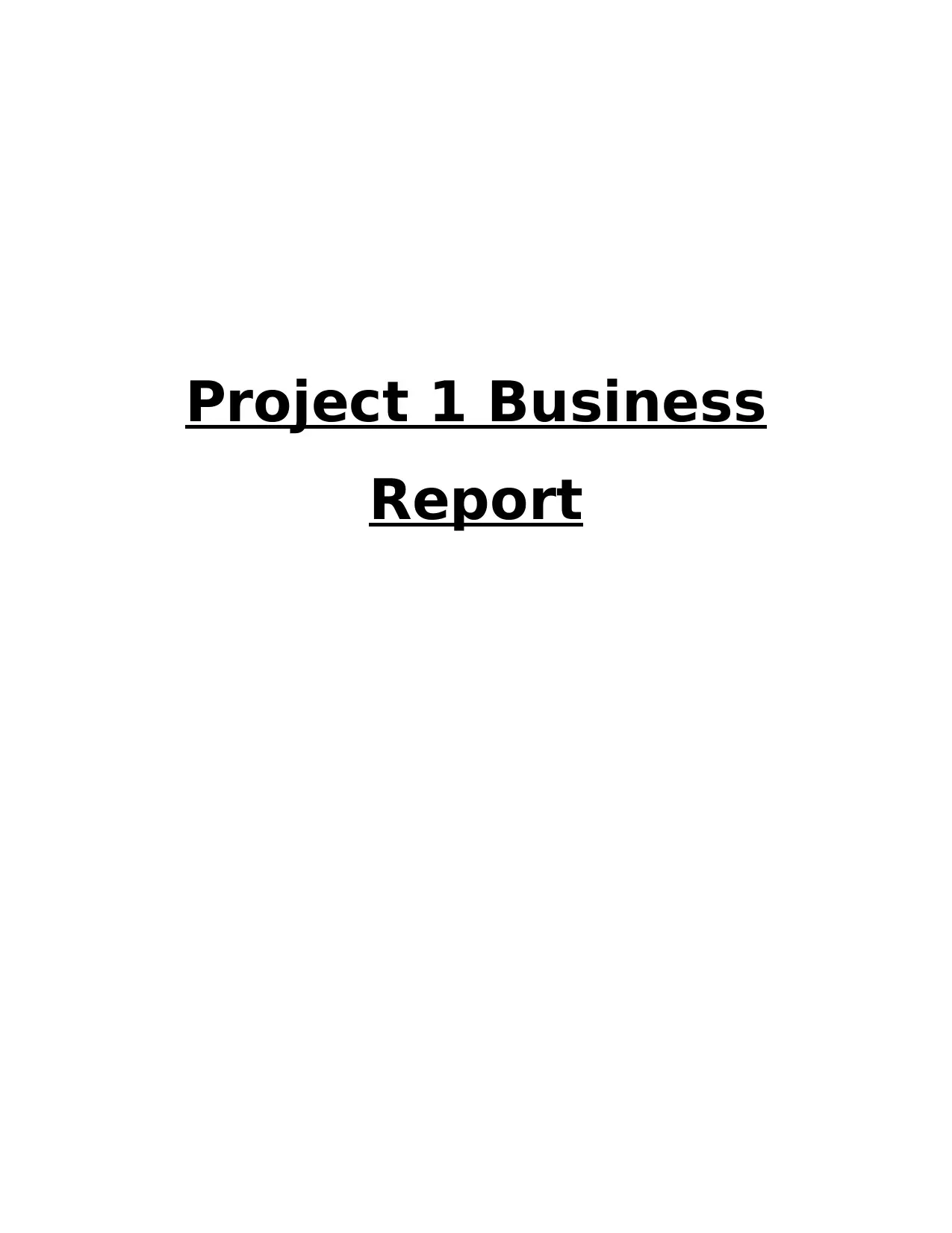
Project 1 Business
Report
Report
Paraphrase This Document
Need a fresh take? Get an instant paraphrase of this document with our AI Paraphraser
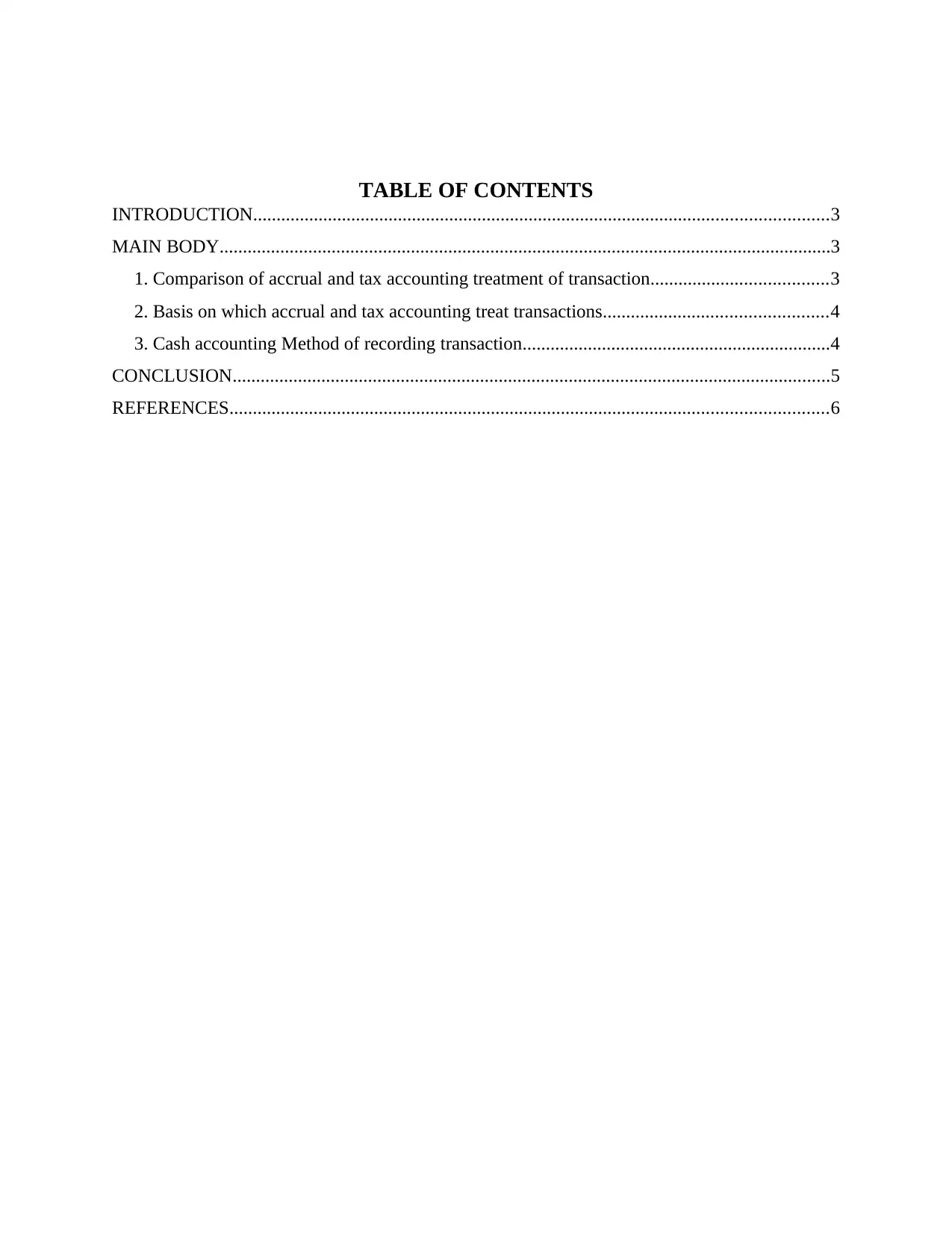
TABLE OF CONTENTS
INTRODUCTION...........................................................................................................................3
MAIN BODY...................................................................................................................................3
1. Comparison of accrual and tax accounting treatment of transaction......................................3
2. Basis on which accrual and tax accounting treat transactions................................................4
3. Cash accounting Method of recording transaction..................................................................4
CONCLUSION................................................................................................................................5
REFERENCES................................................................................................................................6
INTRODUCTION...........................................................................................................................3
MAIN BODY...................................................................................................................................3
1. Comparison of accrual and tax accounting treatment of transaction......................................3
2. Basis on which accrual and tax accounting treat transactions................................................4
3. Cash accounting Method of recording transaction..................................................................4
CONCLUSION................................................................................................................................5
REFERENCES................................................................................................................................6
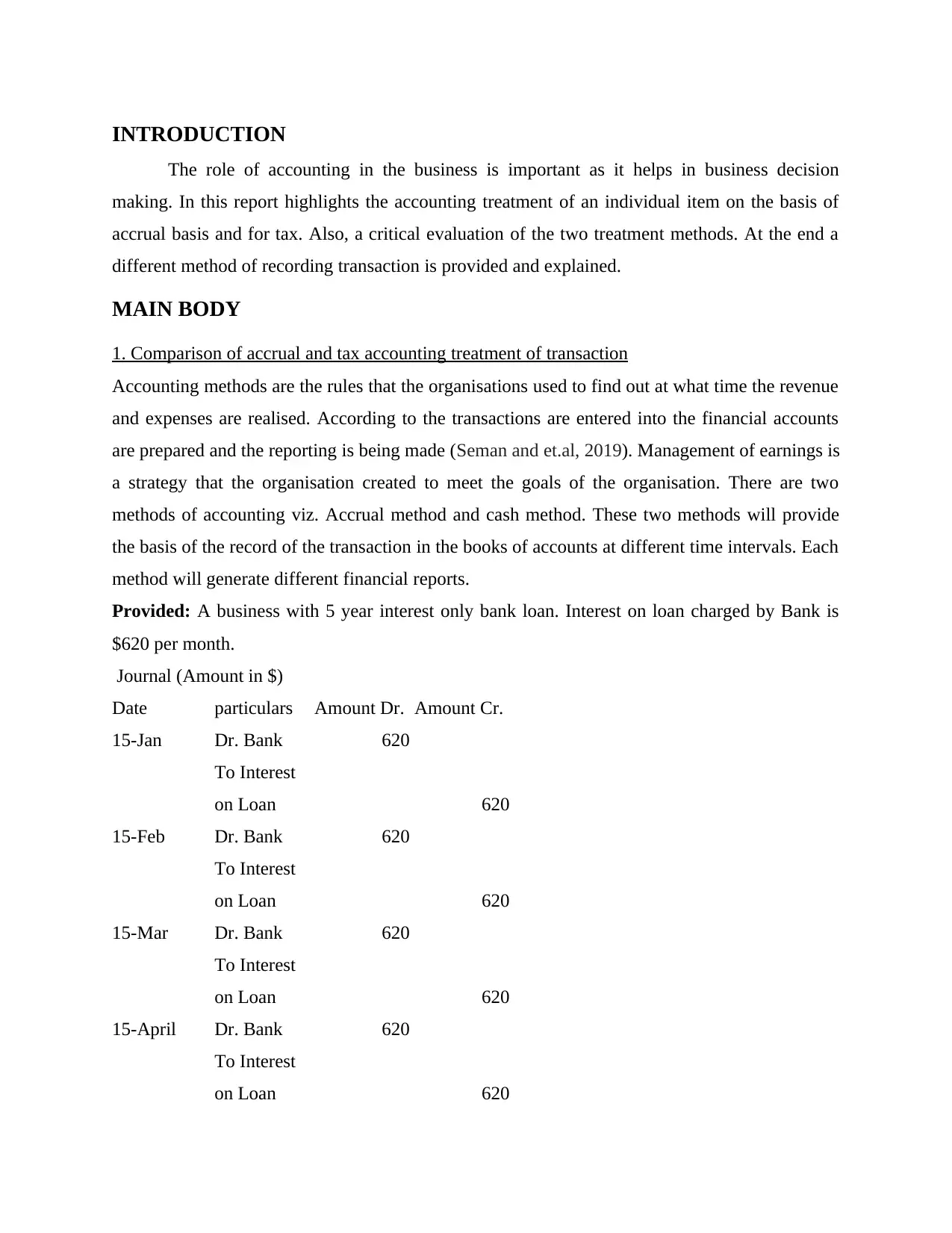
INTRODUCTION
The role of accounting in the business is important as it helps in business decision
making. In this report highlights the accounting treatment of an individual item on the basis of
accrual basis and for tax. Also, a critical evaluation of the two treatment methods. At the end a
different method of recording transaction is provided and explained.
MAIN BODY
1. Comparison of accrual and tax accounting treatment of transaction
Accounting methods are the rules that the organisations used to find out at what time the revenue
and expenses are realised. According to the transactions are entered into the financial accounts
are prepared and the reporting is being made (Seman and et.al, 2019). Management of earnings is
a strategy that the organisation created to meet the goals of the organisation. There are two
methods of accounting viz. Accrual method and cash method. These two methods will provide
the basis of the record of the transaction in the books of accounts at different time intervals. Each
method will generate different financial reports.
Provided: A business with 5 year interest only bank loan. Interest on loan charged by Bank is
$620 per month.
Journal (Amount in $)
Date particulars Amount Dr. Amount Cr.
15-Jan Dr. Bank 620
To Interest
on Loan 620
15-Feb Dr. Bank 620
To Interest
on Loan 620
15-Mar Dr. Bank 620
To Interest
on Loan 620
15-April Dr. Bank 620
To Interest
on Loan 620
The role of accounting in the business is important as it helps in business decision
making. In this report highlights the accounting treatment of an individual item on the basis of
accrual basis and for tax. Also, a critical evaluation of the two treatment methods. At the end a
different method of recording transaction is provided and explained.
MAIN BODY
1. Comparison of accrual and tax accounting treatment of transaction
Accounting methods are the rules that the organisations used to find out at what time the revenue
and expenses are realised. According to the transactions are entered into the financial accounts
are prepared and the reporting is being made (Seman and et.al, 2019). Management of earnings is
a strategy that the organisation created to meet the goals of the organisation. There are two
methods of accounting viz. Accrual method and cash method. These two methods will provide
the basis of the record of the transaction in the books of accounts at different time intervals. Each
method will generate different financial reports.
Provided: A business with 5 year interest only bank loan. Interest on loan charged by Bank is
$620 per month.
Journal (Amount in $)
Date particulars Amount Dr. Amount Cr.
15-Jan Dr. Bank 620
To Interest
on Loan 620
15-Feb Dr. Bank 620
To Interest
on Loan 620
15-Mar Dr. Bank 620
To Interest
on Loan 620
15-April Dr. Bank 620
To Interest
on Loan 620
⊘ This is a preview!⊘
Do you want full access?
Subscribe today to unlock all pages.

Trusted by 1+ million students worldwide
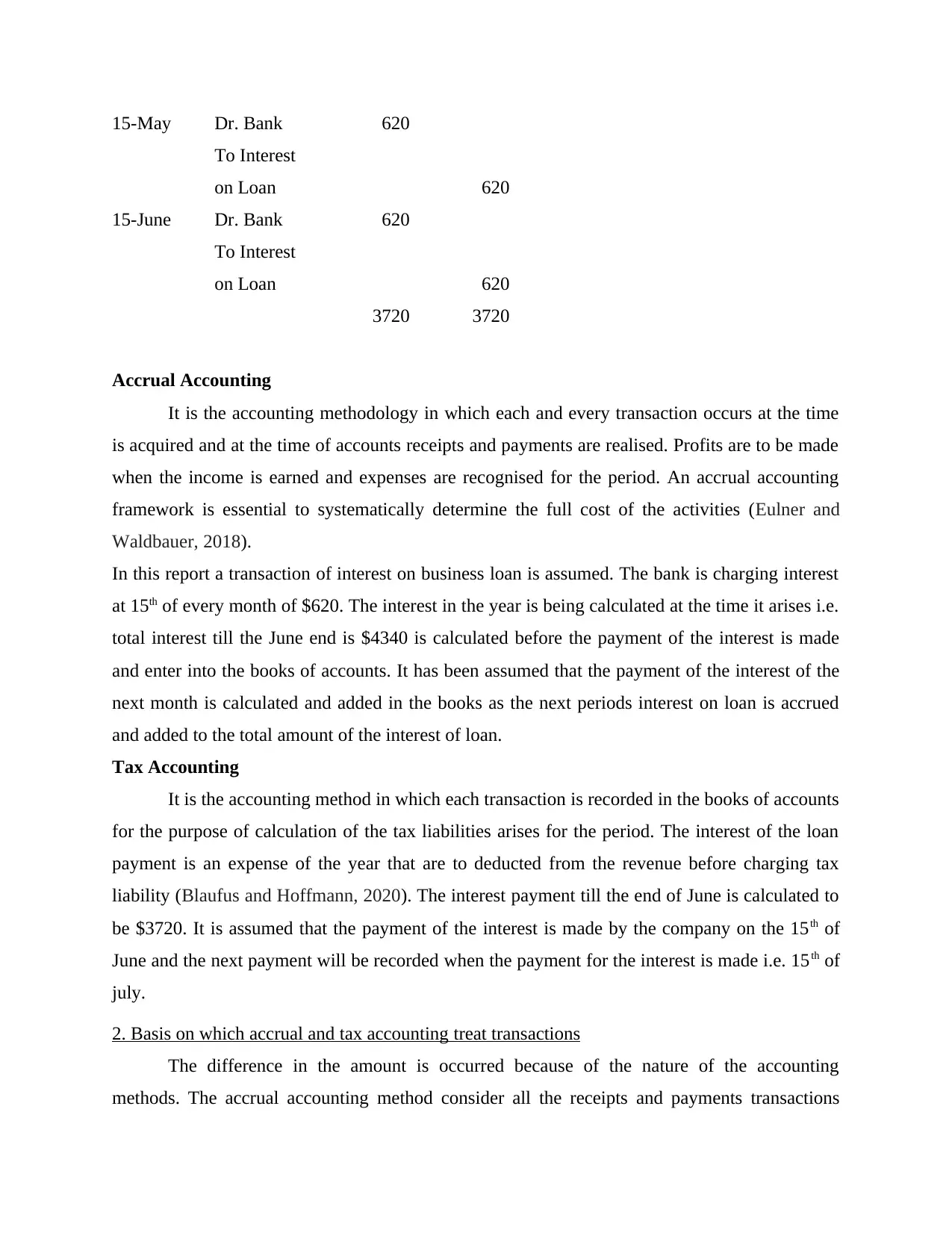
15-May Dr. Bank 620
To Interest
on Loan 620
15-June Dr. Bank 620
To Interest
on Loan 620
3720 3720
Accrual Accounting
It is the accounting methodology in which each and every transaction occurs at the time
is acquired and at the time of accounts receipts and payments are realised. Profits are to be made
when the income is earned and expenses are recognised for the period. An accrual accounting
framework is essential to systematically determine the full cost of the activities (Eulner and
Waldbauer, 2018).
In this report a transaction of interest on business loan is assumed. The bank is charging interest
at 15th of every month of $620. The interest in the year is being calculated at the time it arises i.e.
total interest till the June end is $4340 is calculated before the payment of the interest is made
and enter into the books of accounts. It has been assumed that the payment of the interest of the
next month is calculated and added in the books as the next periods interest on loan is accrued
and added to the total amount of the interest of loan.
Tax Accounting
It is the accounting method in which each transaction is recorded in the books of accounts
for the purpose of calculation of the tax liabilities arises for the period. The interest of the loan
payment is an expense of the year that are to deducted from the revenue before charging tax
liability (Blaufus and Hoffmann, 2020). The interest payment till the end of June is calculated to
be $3720. It is assumed that the payment of the interest is made by the company on the 15th of
June and the next payment will be recorded when the payment for the interest is made i.e. 15th of
july.
2. Basis on which accrual and tax accounting treat transactions
The difference in the amount is occurred because of the nature of the accounting
methods. The accrual accounting method consider all the receipts and payments transactions
To Interest
on Loan 620
15-June Dr. Bank 620
To Interest
on Loan 620
3720 3720
Accrual Accounting
It is the accounting methodology in which each and every transaction occurs at the time
is acquired and at the time of accounts receipts and payments are realised. Profits are to be made
when the income is earned and expenses are recognised for the period. An accrual accounting
framework is essential to systematically determine the full cost of the activities (Eulner and
Waldbauer, 2018).
In this report a transaction of interest on business loan is assumed. The bank is charging interest
at 15th of every month of $620. The interest in the year is being calculated at the time it arises i.e.
total interest till the June end is $4340 is calculated before the payment of the interest is made
and enter into the books of accounts. It has been assumed that the payment of the interest of the
next month is calculated and added in the books as the next periods interest on loan is accrued
and added to the total amount of the interest of loan.
Tax Accounting
It is the accounting method in which each transaction is recorded in the books of accounts
for the purpose of calculation of the tax liabilities arises for the period. The interest of the loan
payment is an expense of the year that are to deducted from the revenue before charging tax
liability (Blaufus and Hoffmann, 2020). The interest payment till the end of June is calculated to
be $3720. It is assumed that the payment of the interest is made by the company on the 15th of
June and the next payment will be recorded when the payment for the interest is made i.e. 15th of
july.
2. Basis on which accrual and tax accounting treat transactions
The difference in the amount is occurred because of the nature of the accounting
methods. The accrual accounting method consider all the receipts and payments transactions
Paraphrase This Document
Need a fresh take? Get an instant paraphrase of this document with our AI Paraphraser
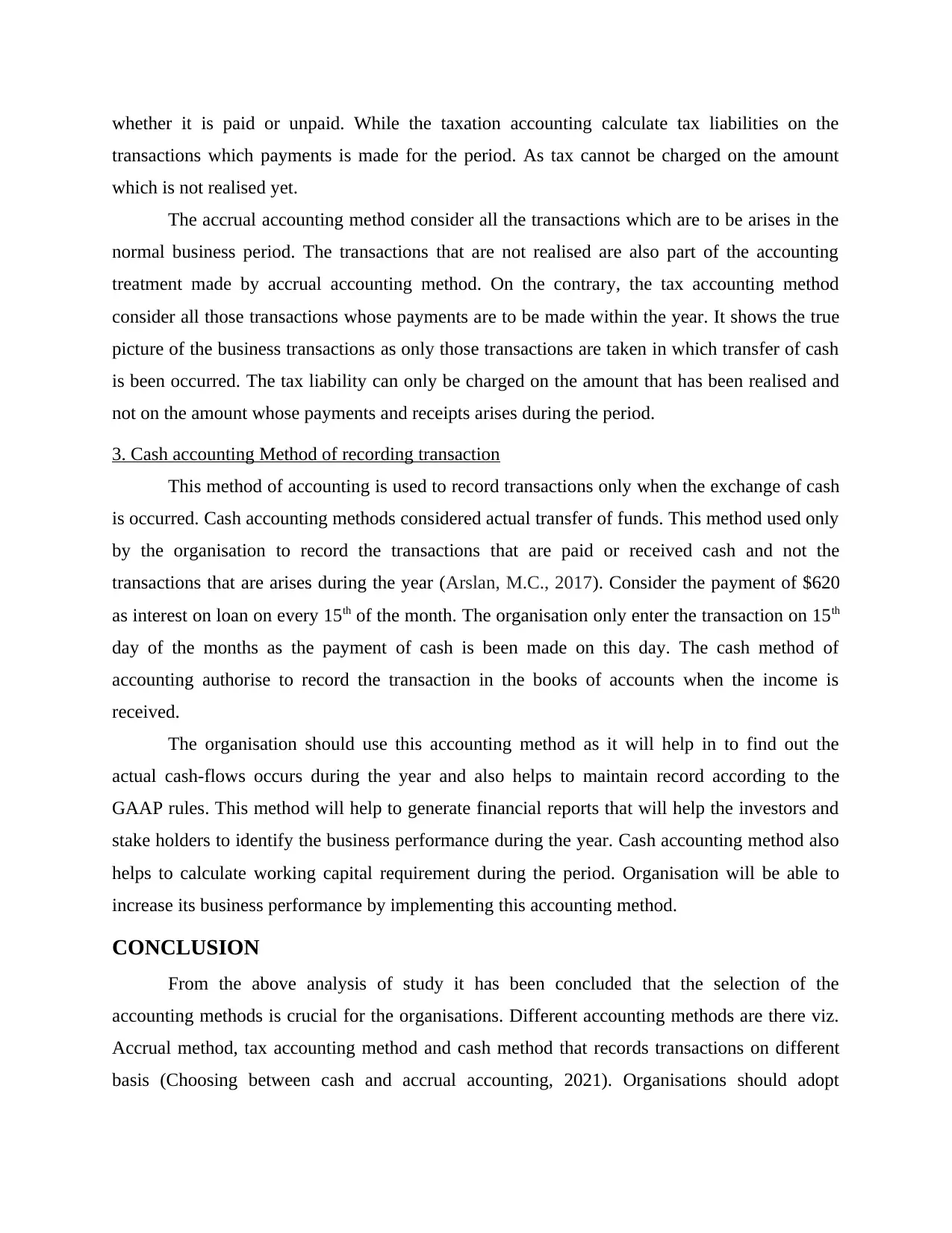
whether it is paid or unpaid. While the taxation accounting calculate tax liabilities on the
transactions which payments is made for the period. As tax cannot be charged on the amount
which is not realised yet.
The accrual accounting method consider all the transactions which are to be arises in the
normal business period. The transactions that are not realised are also part of the accounting
treatment made by accrual accounting method. On the contrary, the tax accounting method
consider all those transactions whose payments are to be made within the year. It shows the true
picture of the business transactions as only those transactions are taken in which transfer of cash
is been occurred. The tax liability can only be charged on the amount that has been realised and
not on the amount whose payments and receipts arises during the period.
3. Cash accounting Method of recording transaction
This method of accounting is used to record transactions only when the exchange of cash
is occurred. Cash accounting methods considered actual transfer of funds. This method used only
by the organisation to record the transactions that are paid or received cash and not the
transactions that are arises during the year (Arslan, M.C., 2017). Consider the payment of $620
as interest on loan on every 15th of the month. The organisation only enter the transaction on 15th
day of the months as the payment of cash is been made on this day. The cash method of
accounting authorise to record the transaction in the books of accounts when the income is
received.
The organisation should use this accounting method as it will help in to find out the
actual cash-flows occurs during the year and also helps to maintain record according to the
GAAP rules. This method will help to generate financial reports that will help the investors and
stake holders to identify the business performance during the year. Cash accounting method also
helps to calculate working capital requirement during the period. Organisation will be able to
increase its business performance by implementing this accounting method.
CONCLUSION
From the above analysis of study it has been concluded that the selection of the
accounting methods is crucial for the organisations. Different accounting methods are there viz.
Accrual method, tax accounting method and cash method that records transactions on different
basis (Choosing between cash and accrual accounting, 2021). Organisations should adopt
transactions which payments is made for the period. As tax cannot be charged on the amount
which is not realised yet.
The accrual accounting method consider all the transactions which are to be arises in the
normal business period. The transactions that are not realised are also part of the accounting
treatment made by accrual accounting method. On the contrary, the tax accounting method
consider all those transactions whose payments are to be made within the year. It shows the true
picture of the business transactions as only those transactions are taken in which transfer of cash
is been occurred. The tax liability can only be charged on the amount that has been realised and
not on the amount whose payments and receipts arises during the period.
3. Cash accounting Method of recording transaction
This method of accounting is used to record transactions only when the exchange of cash
is occurred. Cash accounting methods considered actual transfer of funds. This method used only
by the organisation to record the transactions that are paid or received cash and not the
transactions that are arises during the year (Arslan, M.C., 2017). Consider the payment of $620
as interest on loan on every 15th of the month. The organisation only enter the transaction on 15th
day of the months as the payment of cash is been made on this day. The cash method of
accounting authorise to record the transaction in the books of accounts when the income is
received.
The organisation should use this accounting method as it will help in to find out the
actual cash-flows occurs during the year and also helps to maintain record according to the
GAAP rules. This method will help to generate financial reports that will help the investors and
stake holders to identify the business performance during the year. Cash accounting method also
helps to calculate working capital requirement during the period. Organisation will be able to
increase its business performance by implementing this accounting method.
CONCLUSION
From the above analysis of study it has been concluded that the selection of the
accounting methods is crucial for the organisations. Different accounting methods are there viz.
Accrual method, tax accounting method and cash method that records transactions on different
basis (Choosing between cash and accrual accounting, 2021). Organisations should adopt
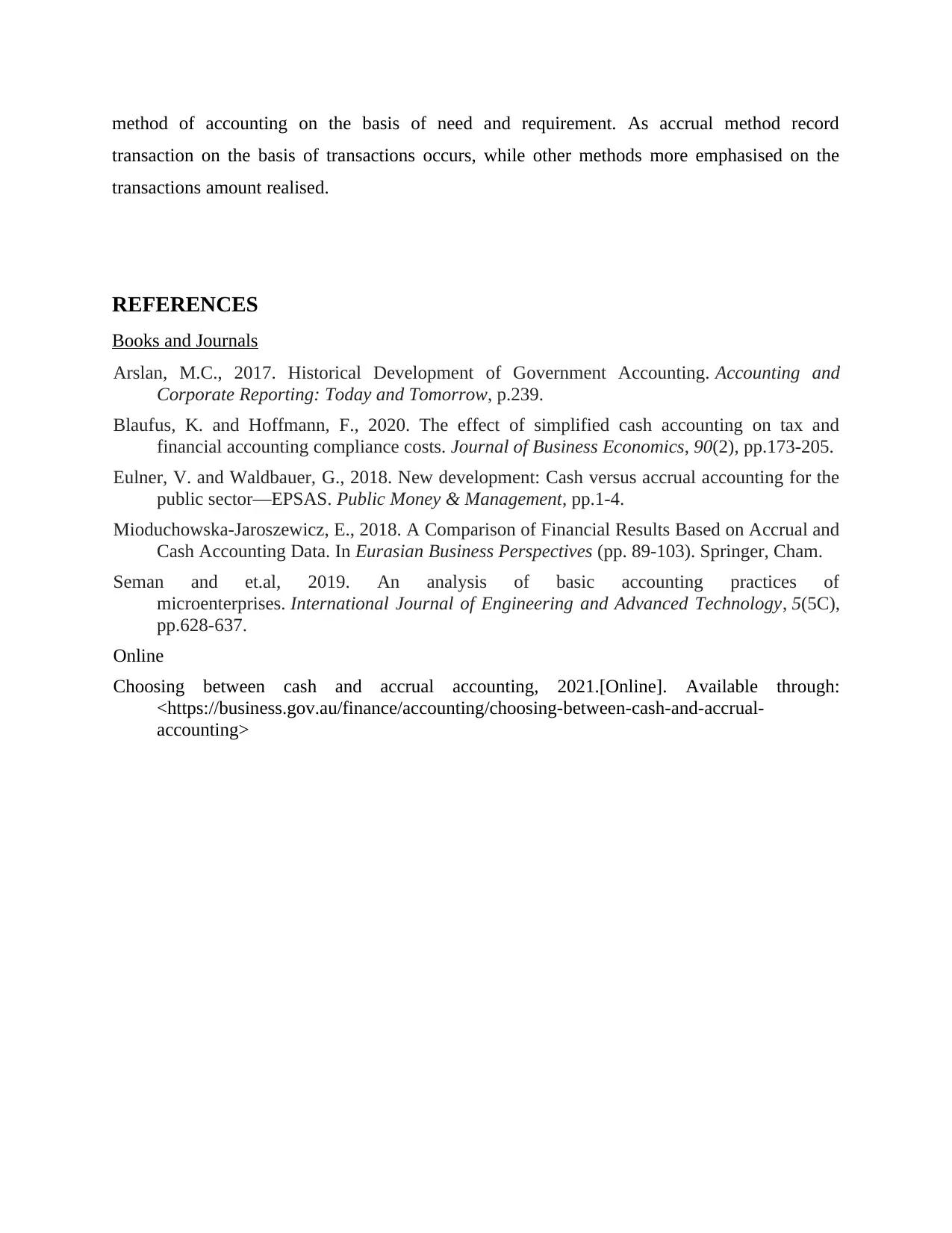
method of accounting on the basis of need and requirement. As accrual method record
transaction on the basis of transactions occurs, while other methods more emphasised on the
transactions amount realised.
REFERENCES
Books and Journals
Arslan, M.C., 2017. Historical Development of Government Accounting. Accounting and
Corporate Reporting: Today and Tomorrow, p.239.
Blaufus, K. and Hoffmann, F., 2020. The effect of simplified cash accounting on tax and
financial accounting compliance costs. Journal of Business Economics, 90(2), pp.173-205.
Eulner, V. and Waldbauer, G., 2018. New development: Cash versus accrual accounting for the
public sector—EPSAS. Public Money & Management, pp.1-4.
Mioduchowska-Jaroszewicz, E., 2018. A Comparison of Financial Results Based on Accrual and
Cash Accounting Data. In Eurasian Business Perspectives (pp. 89-103). Springer, Cham.
Seman and et.al, 2019. An analysis of basic accounting practices of
microenterprises. International Journal of Engineering and Advanced Technology, 5(5C),
pp.628-637.
Online
Choosing between cash and accrual accounting, 2021.[Online]. Available through:
<https://business.gov.au/finance/accounting/choosing-between-cash-and-accrual-
accounting>
transaction on the basis of transactions occurs, while other methods more emphasised on the
transactions amount realised.
REFERENCES
Books and Journals
Arslan, M.C., 2017. Historical Development of Government Accounting. Accounting and
Corporate Reporting: Today and Tomorrow, p.239.
Blaufus, K. and Hoffmann, F., 2020. The effect of simplified cash accounting on tax and
financial accounting compliance costs. Journal of Business Economics, 90(2), pp.173-205.
Eulner, V. and Waldbauer, G., 2018. New development: Cash versus accrual accounting for the
public sector—EPSAS. Public Money & Management, pp.1-4.
Mioduchowska-Jaroszewicz, E., 2018. A Comparison of Financial Results Based on Accrual and
Cash Accounting Data. In Eurasian Business Perspectives (pp. 89-103). Springer, Cham.
Seman and et.al, 2019. An analysis of basic accounting practices of
microenterprises. International Journal of Engineering and Advanced Technology, 5(5C),
pp.628-637.
Online
Choosing between cash and accrual accounting, 2021.[Online]. Available through:
<https://business.gov.au/finance/accounting/choosing-between-cash-and-accrual-
accounting>
⊘ This is a preview!⊘
Do you want full access?
Subscribe today to unlock all pages.

Trusted by 1+ million students worldwide
1 out of 6
Related Documents
Your All-in-One AI-Powered Toolkit for Academic Success.
+13062052269
info@desklib.com
Available 24*7 on WhatsApp / Email
![[object Object]](/_next/static/media/star-bottom.7253800d.svg)
Unlock your academic potential
Copyright © 2020–2025 A2Z Services. All Rights Reserved. Developed and managed by ZUCOL.




